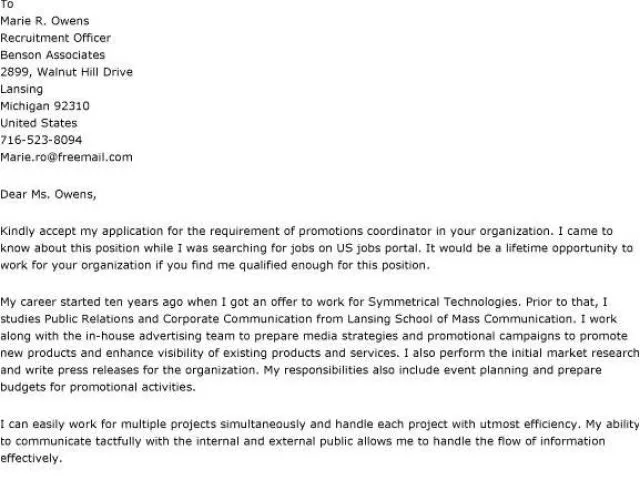Seeking a promotion can be a pivotal moment in your career, a chance to climb the ladder and take on new challenges. But before you can step into that new role, you’ll likely need a powerful tool that can set you apart from the competition a promotion cover letter. This guide will show you how to write a compelling cover letter that highlights your achievements, demonstrates your value, and increases your chances of securing that well-deserved promotion.
Why You Need a Promotion Cover Letter
A promotion cover letter isn’t just a formality; it’s a strategic move to showcase your suitability for the desired role. It provides a targeted opportunity to highlight your skills, accomplishments, and enthusiasm, going beyond the information presented in your resume. It shows you understand what it takes to succeed.
Understanding the Goal of Your Cover Letter
The primary goal of your promotion cover letter is to persuade the hiring manager that you are the best candidate for the promotion. It’s about demonstrating how your past contributions and future potential align with the needs of the new position. A well-crafted letter showcases your achievements, and expresses a clear understanding of the new role and how you will excel within it.
Highlighting Your Achievements
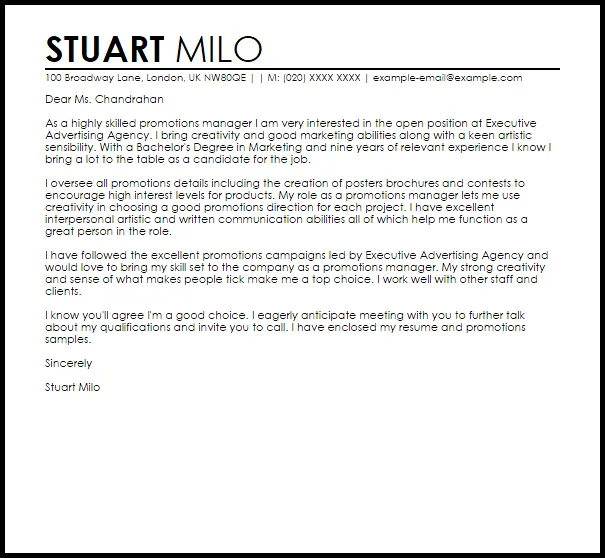
When writing your cover letter, focus on your achievements rather than just listing your job duties. Use action verbs to describe what you have accomplished in your current role. For example, instead of saying “Managed customer accounts,” write “Increased customer retention by 15% by implementing a new client communication strategy.”
Quantifying Your Accomplishments
Whenever possible, quantify your achievements with numbers and data. This makes your claims more credible and impactful. For instance, if you improved sales, mention the percentage increase. If you reduced costs, specify the amount saved. Quantifiable results provide concrete evidence of your value and effectiveness.
Tailoring Your Letter to the Role
Customize your cover letter for the specific promotion you are seeking. Read the job description carefully and identify the key skills and qualifications the company is looking for. Then, align your achievements and experiences to those requirements. Demonstrate how your skills and experiences make you the ideal candidate for the specific role.
Structuring Your Promotion Cover Letter
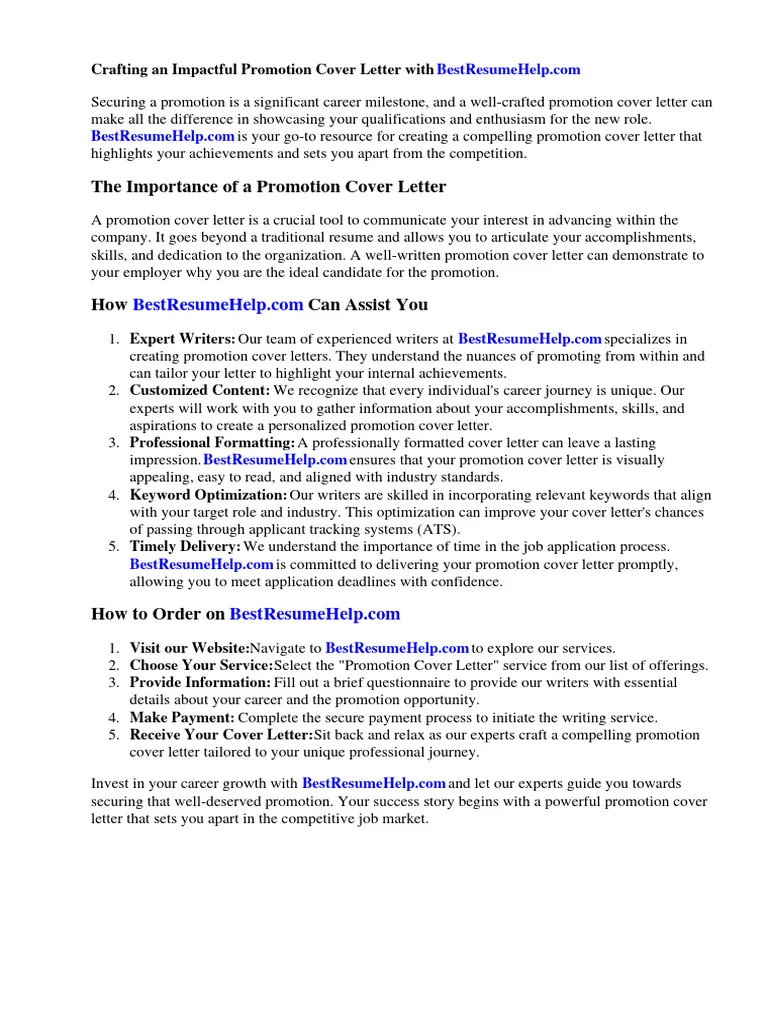
A well-structured cover letter is easy to read and understand. It presents your qualifications in a clear, concise, and compelling manner. Adhere to a professional format to ensure your message is effectively conveyed to the hiring manager. Consider the structure to properly showcase your skills.
Header and Contact Information
Start with your contact information (name, address, phone number, and email address) at the top of the letter. Include the date and the hiring manager’s name and title. If you don’t know the hiring manager’s name, research it or use a general salutation like ‘Dear Hiring Manager’.
Salutation
Use a professional salutation, such as “Dear Mr./Ms. [Last Name]” if you know the hiring manager’s name. If you are unsure, use “Dear Hiring Manager.” Avoid generic salutations like “To Whom It May Concern.”
Opening Paragraph
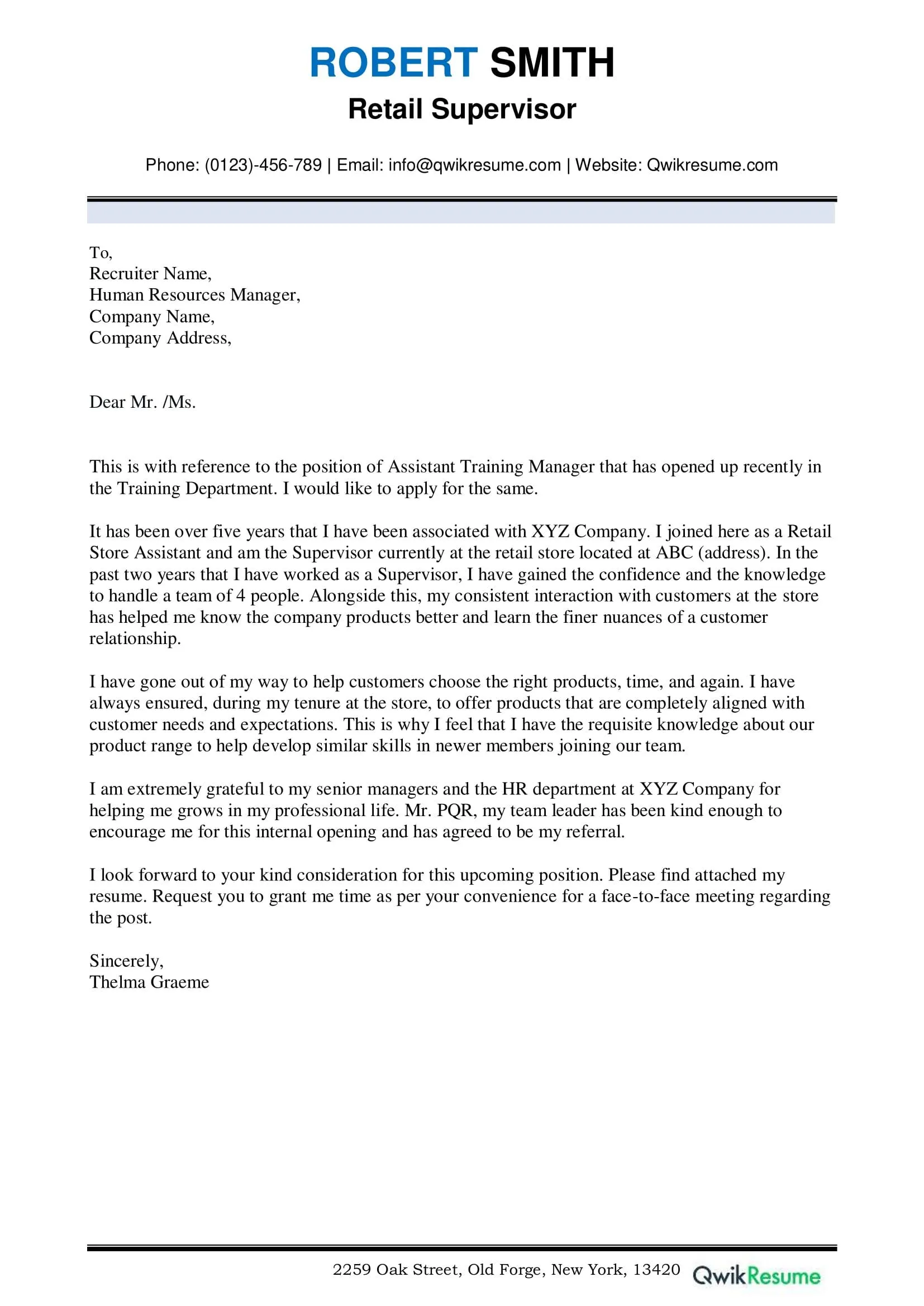
In your opening paragraph, state the position you are applying for and how you learned about it. Briefly mention why you are interested in the promotion and what you hope to achieve in the role. You should make it clear why you are writing the letter and what you are seeking.
Body Paragraphs
Use the body paragraphs to highlight your relevant skills, accomplishments, and experiences. Provide specific examples to support your claims. Explain how your skills and experiences align with the requirements of the new position. Structure each paragraph around a key point or achievement to keep the letter focused.
Closing Paragraph
In your closing paragraph, reiterate your interest in the promotion and express your gratitude for the opportunity. Thank the hiring manager for their time and consideration. Include a call to action, such as “I look forward to discussing my qualifications further in an interview.”
Formatting Your Cover Letter
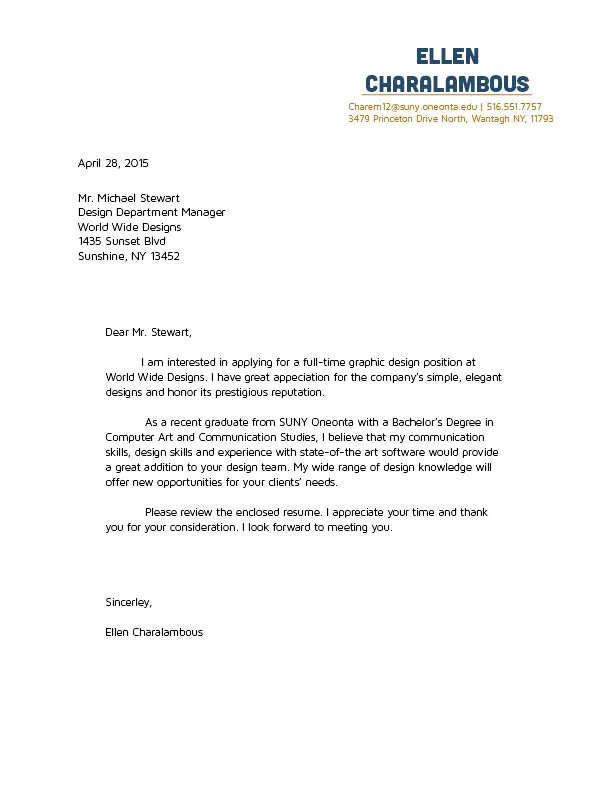
Use a professional and easy-to-read font, such as Times New Roman or Arial, with a font size of 11 or 12 points. Keep the letter concise and well-organized, typically no more than one page. Use clear formatting, including paragraph breaks, bullet points, and white space, to enhance readability.
Essential Elements to Include in Your Cover Letter
A successful promotion cover letter incorporates several key elements that showcase your suitability for the role. By focusing on these elements, you can increase the impact of your letter and demonstrate your value to the company.
Demonstrating Skills and Experience
Highlight the skills and experiences that align with the job description. Provide examples of how you have utilized these skills in your current role to achieve positive results. Your cover letter should be a showcase of your ability to perform the duties of the role.
Expressing Enthusiasm and Interest
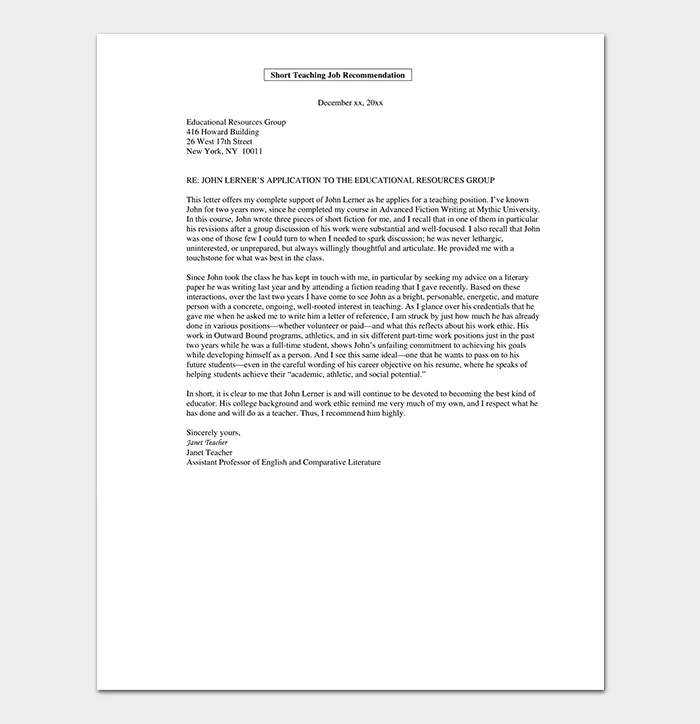
Show your enthusiasm for the promotion and express your interest in the company’s future. Demonstrate your commitment to the company’s goals and your eagerness to contribute to its success. Your enthusiasm can be a powerful way to stand out among other candidates.
Showcasing Alignment with Company Values
Demonstrate how your values and work ethic align with the company’s values. This can include references to teamwork, innovation, customer service, or other company-specific values. Showing that you are a cultural fit can significantly increase your chances of being selected for the promotion.
Proofreading and Editing Your Letter
Thorough proofreading and editing are critical to ensure your cover letter is free of errors. Errors can damage your credibility. Use grammar and spell-check tools, but also carefully review the letter yourself. Have someone else read it to catch mistakes you might have missed. Aim for clarity, conciseness, and professionalism in your writing.
Mistakes to Avoid in Your Cover Letter
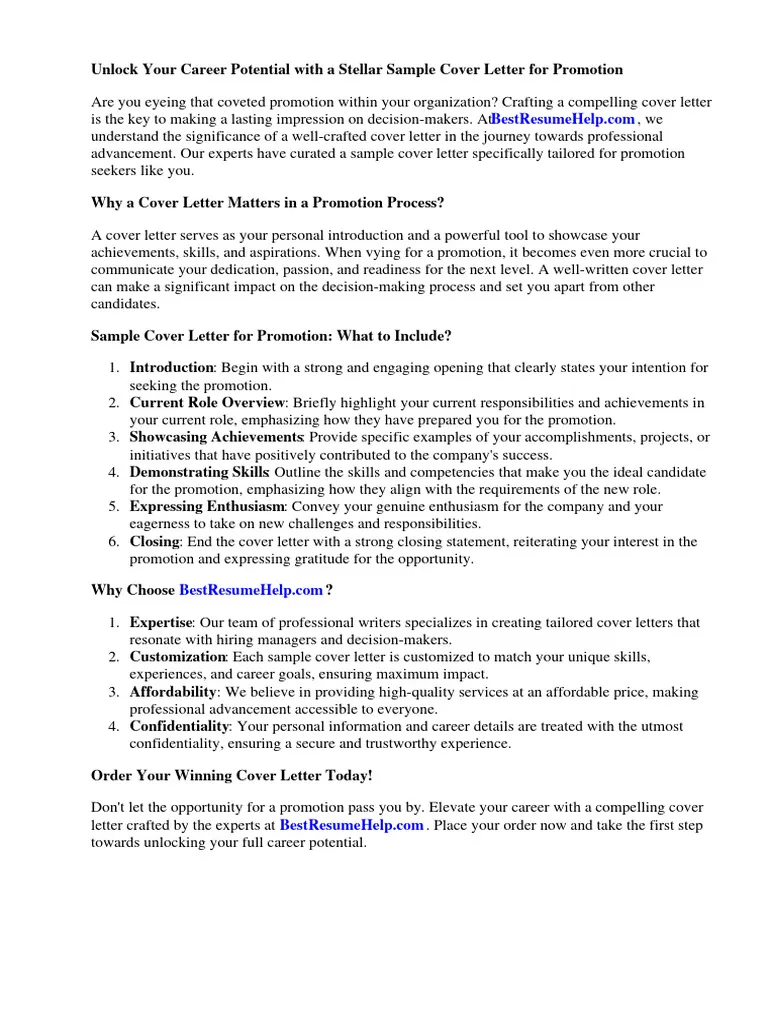
Certain mistakes can significantly reduce the effectiveness of your promotion cover letter. Being aware of these pitfalls can help you avoid them and increase your chances of success. The best approach is to be as informed as possible of the common mistakes and proactively avoid them.
Not Tailoring to the Role
Using a generic cover letter without tailoring it to the specific promotion is a common mistake. Your letter should directly address the requirements of the new role and highlight your relevant qualifications. A generic letter is not likely to impress the hiring manager.
Focusing on Job Duties Instead of Achievements
Listing your job duties without highlighting your accomplishments is another frequent mistake. Instead of simply stating what you did, explain what you achieved and the impact of your work. Focus on accomplishments that demonstrate your value and your suitability for the new role.
Using Generic Language
Using vague and generic language makes your letter less compelling. Avoid clichés and overused phrases. Instead, use specific examples and quantifiable results to showcase your skills and experiences. Being as specific as possible is critical to your success.
Common Promotion Cover Letter Templates
Using a template can provide a framework for your cover letter, but it’s essential to personalize the template to fit your specific situation. Consider these common template approaches to create a cover letter that stands out.
Template 1 Focus on Achievements
This template emphasizes your accomplishments and provides specific examples of your achievements. It’s an ideal approach if you have a strong track record of results. Showcase measurable achievements throughout your cover letter.
Template 2 Skills-Based Approach
This template focuses on highlighting your skills and how they align with the requirements of the new role. It’s suitable if the job description emphasizes specific skills. Show how you have mastered the required skills.
Template 3 Highlighting Company Alignment
This template focuses on demonstrating your understanding of the company’s values and goals and how your contributions have aligned with them. It’s a good choice if you want to showcase your cultural fit. Make sure you know the company’s goals and how your contributions help reach them.
Finalizing and Submitting Your Cover Letter
Before submitting your cover letter, review it one last time for any errors. Ensure that the letter is properly formatted and that all your contact information is correct. Once you are satisfied, submit your cover letter along with your resume. Good luck with your promotion!
Writing a compelling promotion cover letter can significantly increase your chances of being selected for the role. Remember to tailor your letter to the specific position, highlight your achievements, and demonstrate your enthusiasm. By following these guidelines, you can create a cover letter that will help you achieve your career goals.
